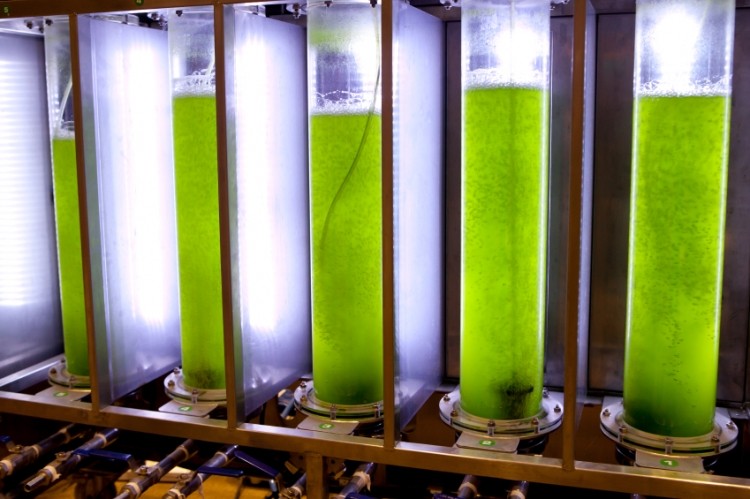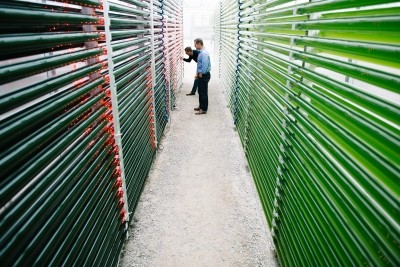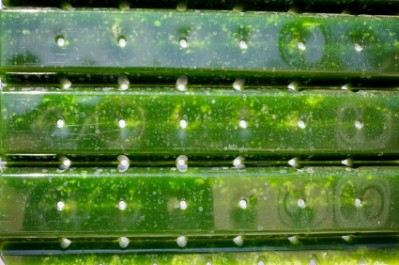New bioreactor to speed production of microalgae for feed, fuel uses

The team included researchers from Washington State University and the National University of Colombia. The group published their results in the journal of Algal Research.
The goals of the project included developing the mixotrophic algal biofilm reactor incorporating glycerol and urea for sources of carbon and nitrogen; establish the biomass and lipid production; estimate fatty acid profiles; and to quantify dissolved oxygen and pH depth profiles in different conditions, they said.
Another goal was to see if there would be faster ways to grow microalgae, said Haluk Beyenal, corresponding author and professor in the Gene and Lina Voiland School of Chemical Engineering and Bioengineering at Washington State University.
The new bioreactor can grow algae in about four days, and because the algae is grown on a membrane it should be easier to collect than it would be in other systems, he said.
“Initially we had no commercial interest, we wanted to understand how it worked,” he told FeedNavigator. “It looked like it would take a month or two months to grow what we wanted and then we grew it faster and we have a technology – from a fundamental question to an application, this is where we are.”
The bioreactor is able to produce amounts of the microalgae Chlorella vulgaris (C. vulgaris) using low light and less water, and offering a high oil yield, the researchers said in the study.
“In this work, Chlorella vulgaris biofilms were effectively grown under mixotrophic conditions in a newly developed biofilm reactor,” the researchers said. “The recycled membrane biofilm reactor we developed allowed the recirculation of dissolved gases and medium through the biofilm and allowed C. vulgaris to grow effectively.”
Why alter biofilm reactor production?
Interest in growing algae on a biofilm started with a student’s project several years ago, said Beyenal. However, it took several tries before the project came together.
“We tried many different methods and failed, and [we] then this system started to work and replicated it and brought out this new reactor,” he said. The group has since submitted it for a patent, he added.
Algal biomass has potential as an ingredient in feed, food and biofuel production along with uses in other areas, the researchers said. The ability to integrate algae production in different industries is of great interest as algae could limit some greenhouse gas emissions and filter wastewater.
Currently, most microalgae biomass is grown using raceway ponds, but biofilm reactors offer an alternative technology to existing systems because they can support high-density production, the researchers said. Such systems also may need less water and have a smaller footprint.
But more development of biofilm reactors is needed as is a more complete understanding of “microalga biofilm processes,” they said.
“In a biofilm reactor, microalgae grow on a surface while receiving nutrients and light,” said the researchers. “The light is usually delivered from the top of the biofilm, whereas nutrients are delivered either from the top or from the bottom.”
In mixotrophic cultivation, an external supply of organic carbon is needed, and glycerol use offers potential because it is a by-product of biodiesel, they said. The group also examined the use of urea as an inexpensive nitrogen source with little pH fluctuation.
“Potentially glycerol and urea can be used in a biofilm reactor while a biofilm is generated mixotrophically,” they said. “To the best of our knowledge, mixotrophic biofilms using glycerol and urea have not been studied.”
Process, findings and next steps
The group tried several different mediums before finding that using a flow-through method with a biofilm would produce the algae growth they were seeking, said Beyenal.
The production process also can be used to generate microalgae that is easy to collect with a high in lipid content, he said.
“Growing it that quickly was surprising to us,” he said.
The system developed uses a cone to focus liquid medium through a biofilm several times using different light conditions, the researchers said. After 192 hours of biomass growth, the cells were collected from the membrane.
Using 5g L-1 glycerol concentration the reactor generated algae with a growth rate of 0.59 ± 0.018 d− 1, leading to production of 12.64 ± 0.94 g dry weight m− 2 d− 1 after 192 hours, they said. When that level of glycerol was used, the lipid content was about 23.91% and the fatty acid profile had low saturated fats with an increase of unsaturated oil.
Another advantage of the reactor is that it can be used for production in smaller spaces, said Beyenal.
However, preparation for scaling up production or making larger versions likely would depend on commercial funding and interest, he said.
The first step in forming the system was to have it work with multiple passes of water through the system, he said. But it remains a work in progress and techniques still need to be optimized.
“This is a new reactor type,” he said. “It works in the lab, and works with the low light-light penetration.”
“Our next approach is to use the system in wastewater treatment,” he said, adding that there are some additional aspects that have to be considered in that process, like accounting for contamination and the waste level in the system.
Source: Algal Research
Title: Biomass production in Chlorella vulgaris biofilm cultivated under mixotrophic growth conditions
DOI: 10.1016/j.algal.2017.07.014
Authors: Sandra Rincon, Hernan Romero, Wrya Aframehr, Haluk Beyenal












